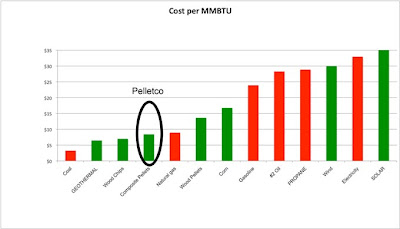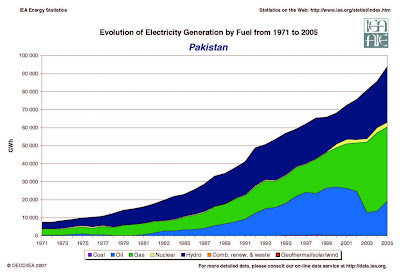Pakistan Needs a Comprehensive National Energy Plan
By Riaz Haq
CA
Since the middle of the 18th century, the Industrial Revolution has transformed the world. Energy-hungry machines are now doing more and more of the work at much higher levels of productivity than humans and animals who did it in pre-industrial era. In recent years, the rapid growth in computers and mobile phones spawned by the Information and Communications Technology (ICT) revolution has further increased the demand for energy. Currently, somewhere between 5-10% of electrical consumption is for ICT and it's likely to continue to grow rapidly.
Energy Consumption
Energy consumption in this day and age generally indicates a nation's level of industrialization, productivity and standard of living. Going by this yardstick, Pakistan's 14 million BTUs per capita consumption indicates that the country has a long way to go to achieve levels comparable with the world average productivity signified by 71 million BTUs per capita as estimated by US Energy Information Administration .
Regional Comparison
Although Pakistan's 14 million BTUs per capita energy use is ahead of Bangladesh's 6 million BTUs and Sri Lanka's 10 million BTUs, it is less than India's 18 million BTUs, and far behind China's 68 million BTUs and Malaysia's 97 million BTUs.
Energy Costs
Fossil fuels are currently the primary source of the bulk of energy used. Cost of producing energ y from various fossil fuels ranges from $2-4 per million BTUs for coal to $19-20 per million BTUs from oil. Costs of energy from natural gas vary widely depending on the source. Cost of shale gas in the United States has plummeted to about $2 per million BTU recently, while Pakistan has signed agreements to purchase gas from Iran and Turkmenistan in the range of $10 to $12 per million BTUs. Cost of production of domestic natural gas is in the range of $2 to $4 per million BTU.

Impact on Economy
Energy costs have had a huge impact on Pakistan's economy . Its heavy dependence on imported oil has been a big contributor to balance of payments crises in the past. In 2008, for example, the oil prices jumped from less than $50 a barrel to $150 a barrel and forced the country to seek IMF bailout . Pakistan oil import bill has increased from about $7 billion in 2007 to over $12 billion in 2011. Energy shortages have also put a significant dent in Pakistan's GDP growth.

Pakistan's Fuel Options
If Pakistan could generate all of the 14 million BTUs of energy per capita from coal, the cost would be $28 to $56 for each person. Alternatively, the cost of using oil for the entire production would add up to about $280 per person, a significant chunk of Pakistan's per capita income of $1372 in 2011-12. The costs therefore range from a low of $28 to a high of $280 per Pakistani.
Energy Policy Suggestions
As the nation develops and the energy demand increases, the policy-makers have to try and produce as much of the needed energy at costs closer to the low-end of the range from $2 to $20 per million BTUs. Here are some policy suggestions for Pakistan's energy policy going forward:
1. Develop Pakistan's shale gas reserves estimated at 51 trillion cubic feet near Karachi in southern Sindh province. The US experience has shown that investment in shale gas can increase production quite rapidly and prices brought down from about $12 per mmBTU in 2008 to under $2 per mmBTU recently. Pursuing this option requires US technical expertise and significant foreign investment on an accelerated schedule.
2. Increase production of gas from nearly 30 trillion cubic feet of remaining conventional gas reserves. This, too, requires significant investment on an accelerated schedule.
3. Convert some of the idle power generation capacity from oil and gas to imported coal to make electricity more available and affordable.
4. Utilize Pakistan's vast coal reserves in Sindh's Thar desert. The problem here is that the World Bank, Asian Development Bank and other international financial institutions (IFIs) are not lending for coal development because of environmental concerns. And the Chinese who were showing interest in the project have since pulled out.
5. Invest in hydroelectric and other renewables including wind and solar. Several of these projects are funded and underway but it'll take a while to bring them online to make a difference.
6. Curb widespread power theft, improve collection of electricity dues from consumers, and resolve spiraling circular debt to make Pakistan's energy sector attractive to domestic and foreign investors.
Energy Conservation
In addition to significantly increasing energy production, Pakistan needs to take prudent steps to conserve by promoting the use of energy-saving electric bulbs and machines. Concerns about the environment have propelled many developed nations to cut energy consumption in recent years. For example, serious conservation efforts have reduced Japan's 172 million BTUs per capita in 2009 down from 178 in 2005, Germany is at 163 million BTUs in 2009 down from 175 in 2005, and the United States is down to 308 million BTUs in 2009 from 340 in 20 about $205.
Summary
Instead of addressing different pieces of the energy puzzle in an ad hoc fashion under multiple ministries and bureaucracies fighting turf battles, Pakistani policy-makers need to look at the big picture for the sake of the nation's future. Nothing short of a holistic approach with a comprehensive energy policy formulated and implemented under a competent and powerful energy czar will do.

